The Effects of Alkyl Chain Combinations on the Structural and Mechanical Properties of Biomimetic Ion Pair Amphiphile Bilayers
Abstract
:1. Introduction
2. Materials and Methods
3. Results and Discussion
3.1. Phase Behaviors of the CmTMA+-CnS− IPA Bilayers at 298 K
3.2. Alkyl Chain Asymmetry Definition
3.3. IPA Bilayer Structural Properties
3.4. IPA Bilayer Mechanical Properties
4. Conclusions
Supplementary Materials
Acknowledgments
Author Contributions
Conflicts of Interest
References
- Lasic, D.D. Novel applications of liposomes. Trends Biotechnol. 1998, 16, 307–321. [Google Scholar] [CrossRef]
- Akbarzadeh, A.; Rezaei-Sadabady, R.; Davaran, S.; Joo, S.W.; Zarghami, N.; Hanifehpour, Y.; Samiei, M.; Kouhi, M.; Nejati-Koshki, K. Liposome: Classification, preparation, and applications. Nanoscale Res. Lett. 2013, 8, 102. [Google Scholar] [CrossRef] [PubMed]
- Verma, G.; Hassan, P.A. Self assembled materials: Design strategies and drug delivery perspectives. Phys. Chem. Chem. Phys. 2013, 15, 17016–17028. [Google Scholar] [CrossRef] [PubMed]
- Kaler, E.W.; Murthy, A.K.; Rodriguez, B.E.; Zasadzinski, J.A.N. Spontaneous vesicle formation in aqueous mixtures of single-tailed surfactants. Science 1989, 245, 1371–1374. [Google Scholar] [CrossRef] [PubMed]
- Aiello, C.; Andreozzi, P.; La Mesa, C.; Risuleo, G. Biological activity of SDS-CTAB cat-anionic vesicles in cultured cells and assessment of their cytotoxicity ending in apoptosis. Colloids Surf. B Biointerfaces 2010, 78, 149–154. [Google Scholar] [CrossRef] [PubMed]
- Fukuda, H.; Kawata, K.; Okuda, H.; Regen, S.L. Bilayer-forming ion-Pair amphiphiles from single-chain surfactants. J. Am. Chem. Soc. 1990, 112, 1635–1637. [Google Scholar] [CrossRef]
- Tondre, C.; Caillet, C. Properties of the amphiphilic films in mixed cationic/anionic vesicles: A comprehensive view from a literature analysis. Adv. Colloid Interface Sci. 2001, 93, 115–134. [Google Scholar] [CrossRef]
- Marques, E.F.; Regev, O.; Khan, A.; Lindman, B. Self-organization of double-chained and pseudodouble-chained surfactants: Counterion and geometry effects. Adv. Colloid Interface Sci. 2003, 100–102, 83–104. [Google Scholar] [CrossRef]
- Soussan, E.; Cassel, S.; Blanzat, M.; Rico-Lattes, I. Drug delivery by soft matter: Matrix and vesicular carriers. Angew. Chem.-Int. Ed. 2009, 48, 274–288. [Google Scholar] [CrossRef] [PubMed]
- Rosa, M.; del Carmen Morán, M.; da Graca Miguel, M.; Lindman, B. The association of DNA and stable catanionic amino acid-based vesicles. Colloids Surf. A Physicochem. Eng. Asp. 2007, 301, 361–375. [Google Scholar] [CrossRef]
- Bramer, T.; Dew, N.; Edsman, K. Pharmaceutical applications for catanionic mixtures. J. Pharm. Pharmacol. 2007, 59, 1319–1334. [Google Scholar] [CrossRef] [PubMed]
- Lee, W.H.; Tang, Y.L.; Chiu, T.C.; Yang, Y.M. Synthesis of ion-pair amphiphiles and calorimetric study on the gel to liquid-crystalline phase transition behavior of their bilayers. J. Chem. Eng. Data 2015, 60, 1119–1125. [Google Scholar] [CrossRef]
- Heimburg, T.; Würz, U.; Marsh, D. Binary phase diagram of hydrated dimyristoylglycerol-dimyristoylphosphatidylcholine mixtures. Biophys. J. 1992, 63, 1369–1378. [Google Scholar] [CrossRef]
- Rodgers, J.M.; Sørensen, J.; De Meyer, F.J.M.; Schiøtt, B.; Smit, B. Understanding the phase behavior of coarse-grained model lipid bilayers through computational calorimetry. J. Phys. Chem. B 2012, 116, 1551–1569. [Google Scholar] [CrossRef] [PubMed]
- Lewis, R.N.A.H.; McElhaney, R.N. Membrane lipid phase transitions and phase organization studied by Fourier transform infrared spectroscopy. Biochim. Biophys. Acta 2013, 1828, 2347–2358. [Google Scholar] [CrossRef] [PubMed]
- Picas, L.; Rico, F.; Scheuring, S. Direct measurement of the mechanical properties of lipid phases in supported bilayers. Biophys. J. 2012, 102, L01–L03. [Google Scholar] [CrossRef] [PubMed]
- Khelashvili, G.; Harries, D. How cholesterol tilt modulates the mechanical properties of saturated and unsaturated lipid membranes. J. Phys. Chem. B 2013, 117, 2411–2421. [Google Scholar] [CrossRef] [PubMed]
- Tu, K.; Tobias, D.J.; Blasie, J.K.; Klein, M.L. Molecular dynamics investigation of the structure of a fully hydrated gel-phase dipalmitoylphosphatidylcholine bilayer. Biophys. J. 1996, 70, 595–608. [Google Scholar] [CrossRef]
- Uppulury, K.; Coppock, P.S.; Kindt, J.T. Molecular Simulation of the DPPE Lipid Bilayer Gel Phase: Coupling between Molecular Packing Order and Tail Tilt Angle. J. Phys. Chem. B 2015, 119, 8725–8733. [Google Scholar] [CrossRef] [PubMed]
- Kuo, A.T.; Chang, C.H.; Shinoda, W. Molecular dynamics study of catanionic bilayers composed of ion pair amphiphile with double-tailed cationic surfactant. Langmuir 2012, 28, 8156–8164. [Google Scholar] [CrossRef] [PubMed]
- Kuo, A.T.; Chang, C.H. Cholesterol-induced condensing and disordering effects on a rigid catanionic bilayer: A molecular dynamics study. Langmuir 2014, 30, 55–62. [Google Scholar] [CrossRef] [PubMed]
- Huang, F.Y.; Chiu, C.C. Interplay between alkyl chain asymmetry and cholesterol addition in the rigid ion pair amphiphile bilayer systems. J. Chem. Phys. 2017, 146, 035102. [Google Scholar] [CrossRef] [PubMed]
- Martinez, L.; Andrade, R.; Birgin, E.G.; Martínez, J.M. PACKMOL: A package for building initial configurations for molecular dynamics simulations. J. Comput. Chem. 2009, 30, 2157–2164. [Google Scholar] [CrossRef] [PubMed]
- Humphrey, W.; Dalke, A.; Schulten, K. VMD: Visual Molecular Dynamics. J. Mol. Graph. 1996, 14, 33–38. [Google Scholar] [CrossRef]
- Hess, B.; Kutzner, C.; Van Der Spoel, D.; Lindahl, E. GRGMACS 4: Algorithms for highly efficient, load-balanced, and scalable molecular simulation. J. Chem. Theory Comput. 2008, 4, 435–447. [Google Scholar] [CrossRef] [PubMed]
- Pronk, S.; Páll, S.; Schulz, R.; Larsson, P.; Bjelkmar, P.; Apostolov, R.; Shirts, M.R.; Smith, J.C.; Kasson, P.M.; Van Der Spoel, D.; et al. GROMACS 4.5: A high-throughput and highly parallel open source molecular simulation toolkit. Bioinformatics 2013, 29, 845–854. [Google Scholar] [CrossRef] [PubMed]
- Klauda, J.B.; Venable, R.M.; Freites, J.A.; O’Connor, J.W.; Tobias, D.J.; Mondragon-Ramirez, C.; Vorobyov, I.; MacKerell, A.D.; Pastor, R.W. Update of the CHARMM all-atom additive force field for lipids: Validation on six lipid types. J. Phys. Chem. B 2010, 114, 7830–7843. [Google Scholar] [CrossRef] [PubMed]
- Lee, S.; Tran, A.; Allsopp, M.; Lim, J.B.; Henin, J.; Klauda, J.B. CHARMM36 United Atom Chain Model for Lipids and Surfactants. J. Phys. Chem. B 2014, 118, 547–556. [Google Scholar] [CrossRef] [PubMed]
- Jorgensen, W.L.; Chandrasekhar, J.; Madura, J.D.; Impey, R.W.; Klein, M.L. Comparison of simple potential functions for simulating liquid water. J. Chem. Phys. 1983, 79, 926. [Google Scholar] [CrossRef]
- Martyna, G.J.; Klein, M.L.; Tuckerman, M. Nose–Hoover chains: The canonical ensemble via continuous dynamics. J. Chem. Phys. 1992, 97, 2635–2643. [Google Scholar] [CrossRef]
- Parrinello, M.; Rahman, A. Polymorphic transitions in single crystals: A new molecular dynamics method. J. Appl. Phys. 1981, 52, 7182–7190. [Google Scholar] [CrossRef]
- Martyna, G.J.; Tobias, D.J.; Klein, M.L. Constant pressure molecular dynamics algorithms. J. Chem. Phys. 1994, 101, 4177. [Google Scholar] [CrossRef]
- Essmann, U.; Perera, L.; Berkowitz, M.L.; Darden, T.; Lee, H.; Pedersen, L.G. A smooth particle mesh Ewald method. J. Chem. Phys. 1995, 103, 8577–8593. [Google Scholar] [CrossRef]
- Hess, B.; Bekker, H.; Berendsen, H.J.C.; Fraaije, J.G.E.M. LINCS: A linear constraint solver for molecular simulations. J. Comput. Chem. 1997, 18, 1463–1472. [Google Scholar] [CrossRef]
- Seelig, J. Deuterium magnetic resonance: Theory and application to lipid membranes. Q. Rev. Biophys. 1997, 10, 353–418. [Google Scholar] [CrossRef]
- Schindler, H.; Seelig, J. Deuterium order parameters in relation to thermodynamic properties of a phospholipid bilayer: A statistical mechanical interpretation. Biochemistry 1975, 14, 2283–2287. [Google Scholar] [CrossRef] [PubMed]
- Heller, H.; Schaefer, M.; Schulten, K. Molecular Dynamics Simulation of a Bilayer of 200 Lipids in the Gel and in the Liquid-Crystal Phases. J. Phys. Chem. 1993, 97, 8343–8360. [Google Scholar] [CrossRef]
- Feller, S.E.; Pastor, R.W. Constant surface tension simulations of lipid bilayers: The sensitivity of surface areas and compressibilities. J. Chem. Phys. 1999, 111, 1281. [Google Scholar] [CrossRef]
- Shinoda, W.; Shinoda, K.; Baba, T.; Mikami, M. Molecular dynamics study of bipolar tetraether lipid membranes. Biophys. J. 2005, 89, 3195–3202. [Google Scholar] [CrossRef] [PubMed]
- Khelashvili, G.; Pabst, G.; Harries, D. Cholesterol orientation and tilt modulus in DMPC bilayers. J. Phys. Chem. B 2010, 114, 7524–7534. [Google Scholar] [CrossRef] [PubMed]
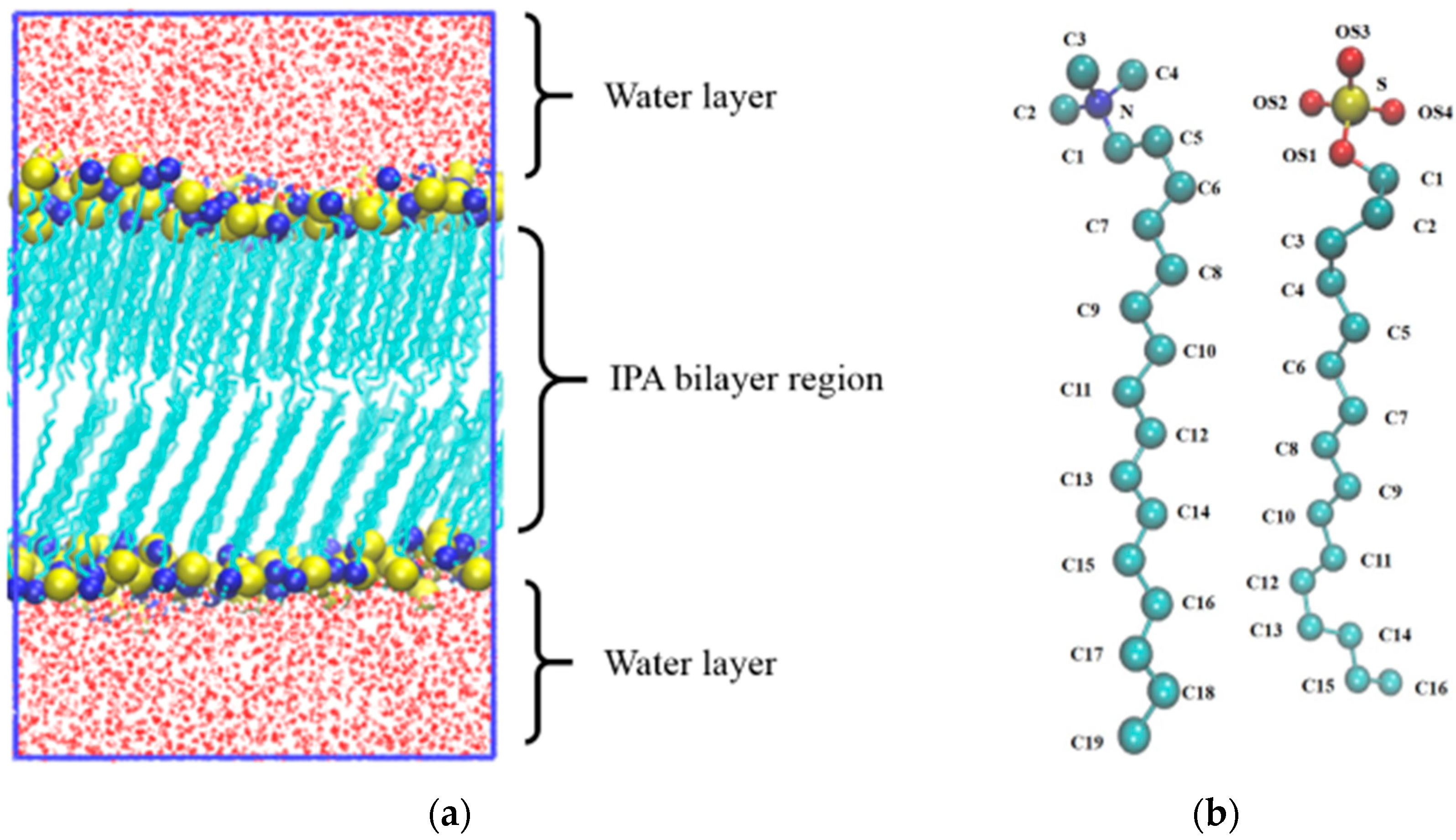

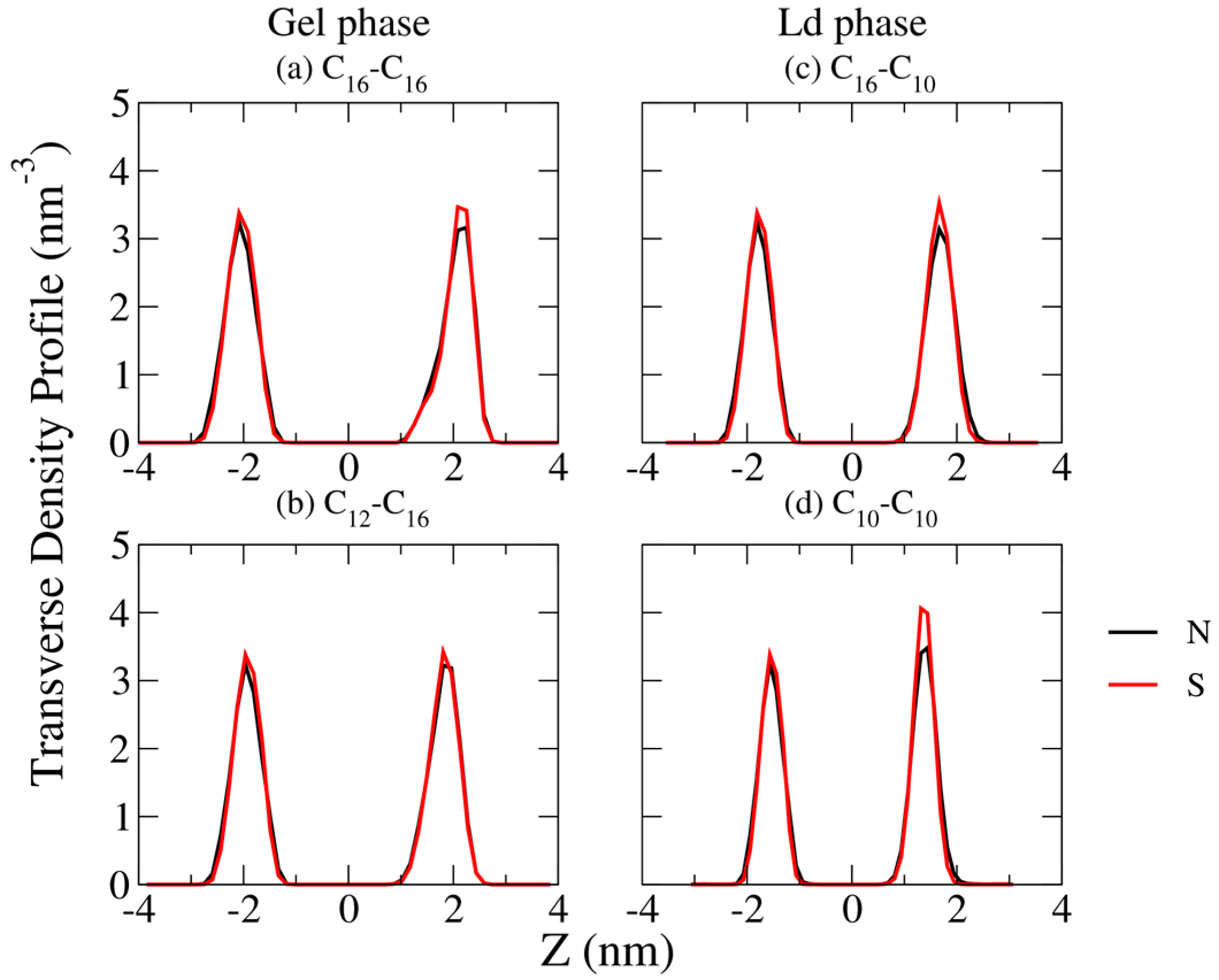

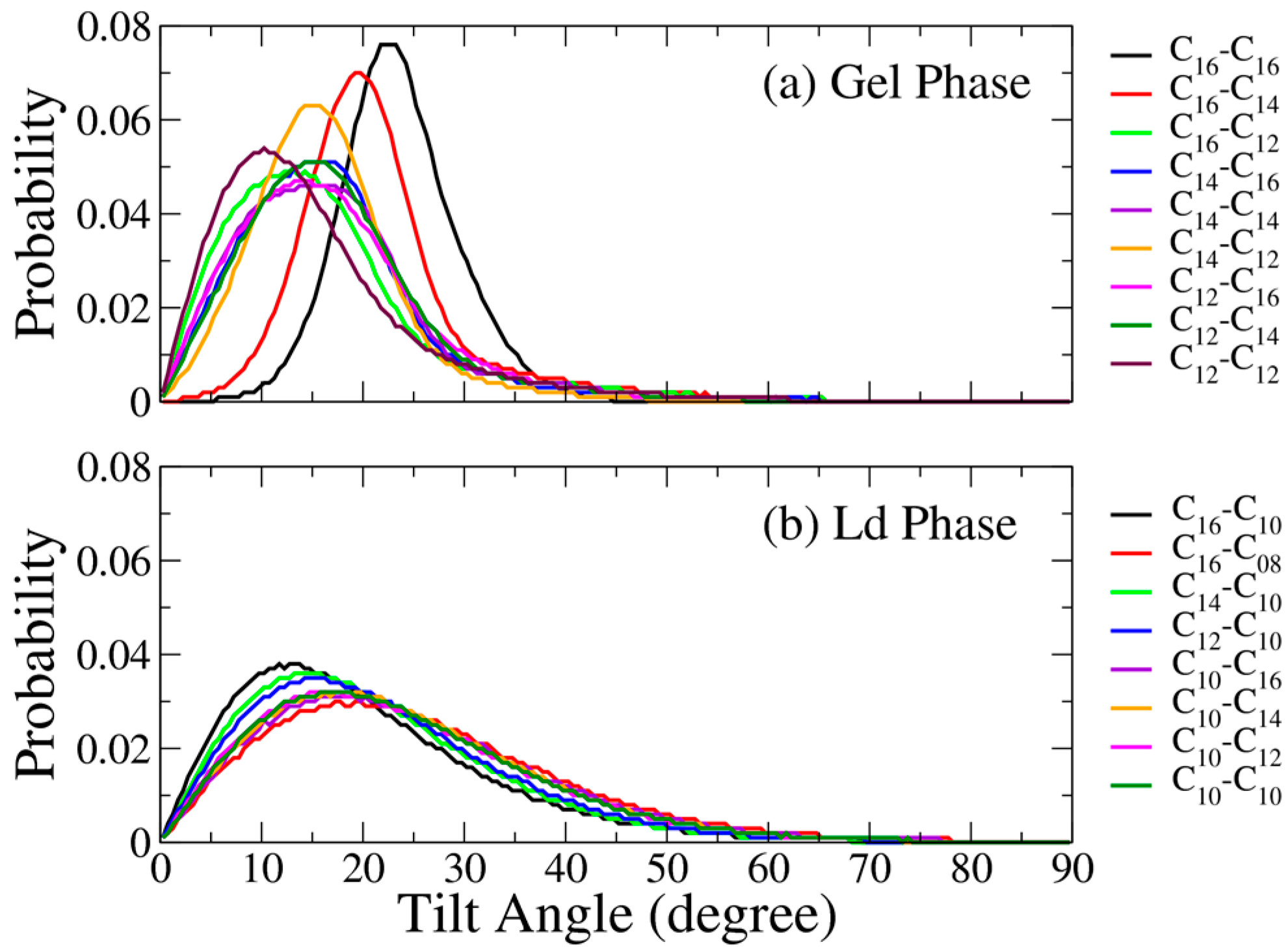
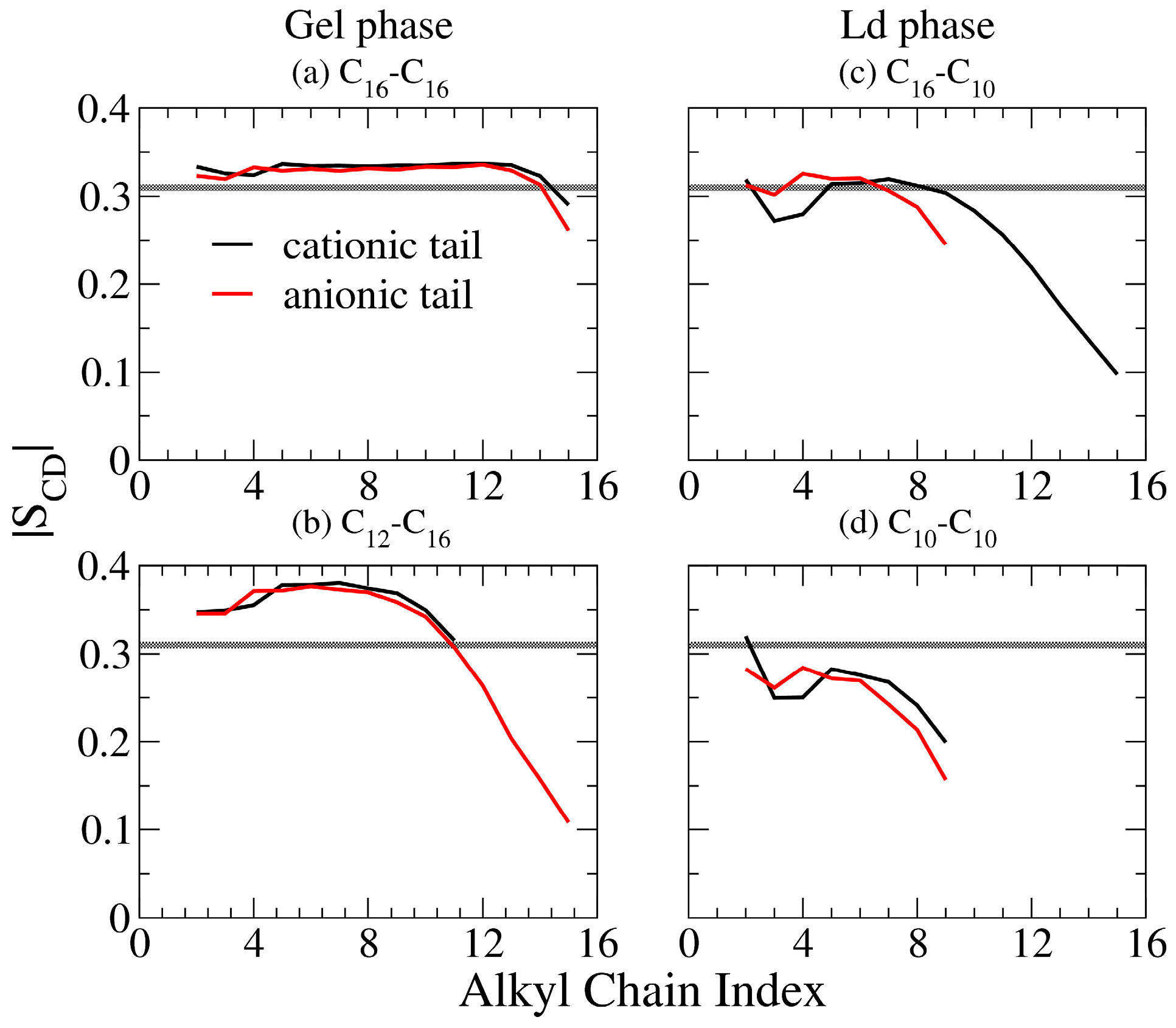
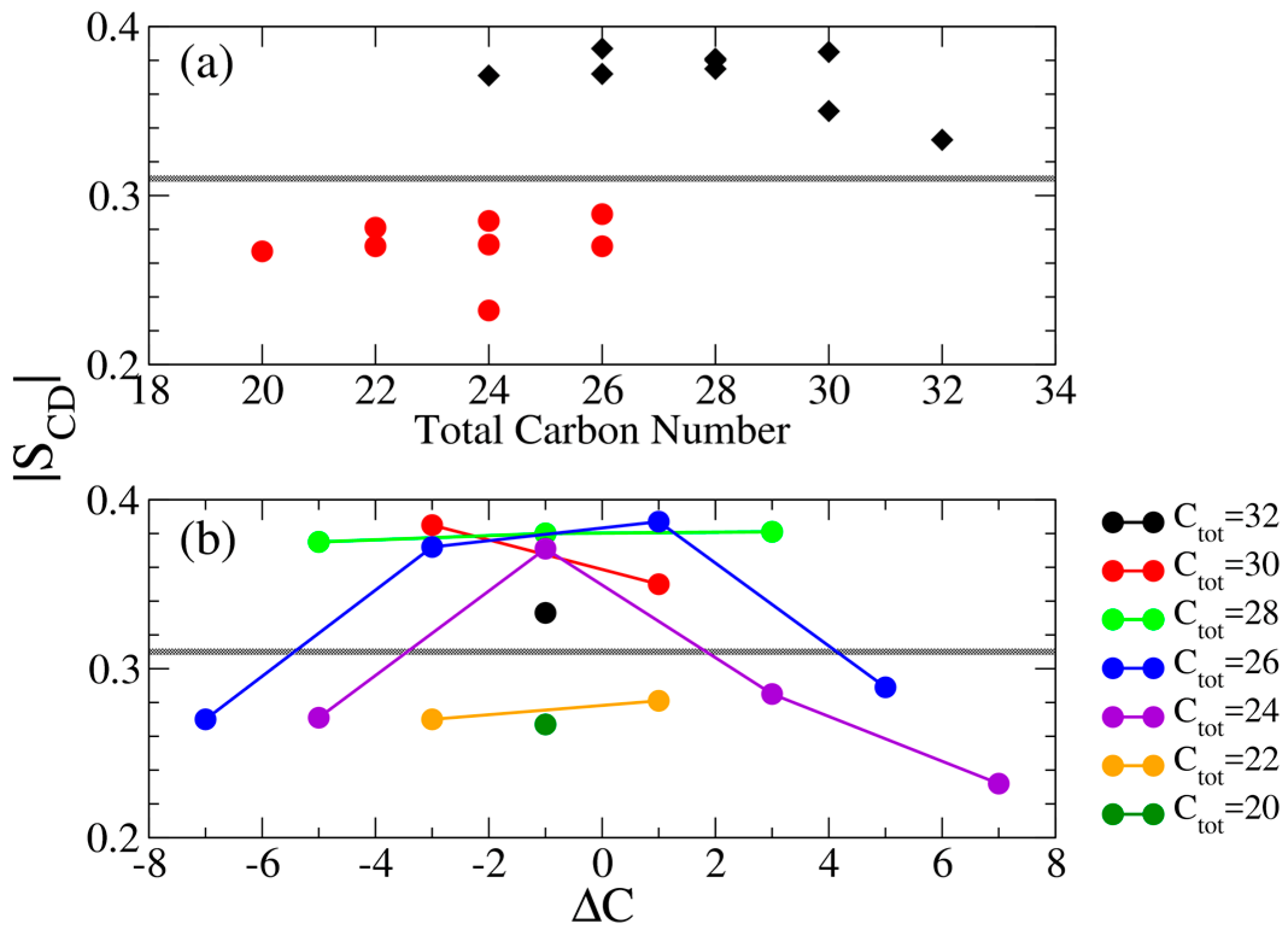
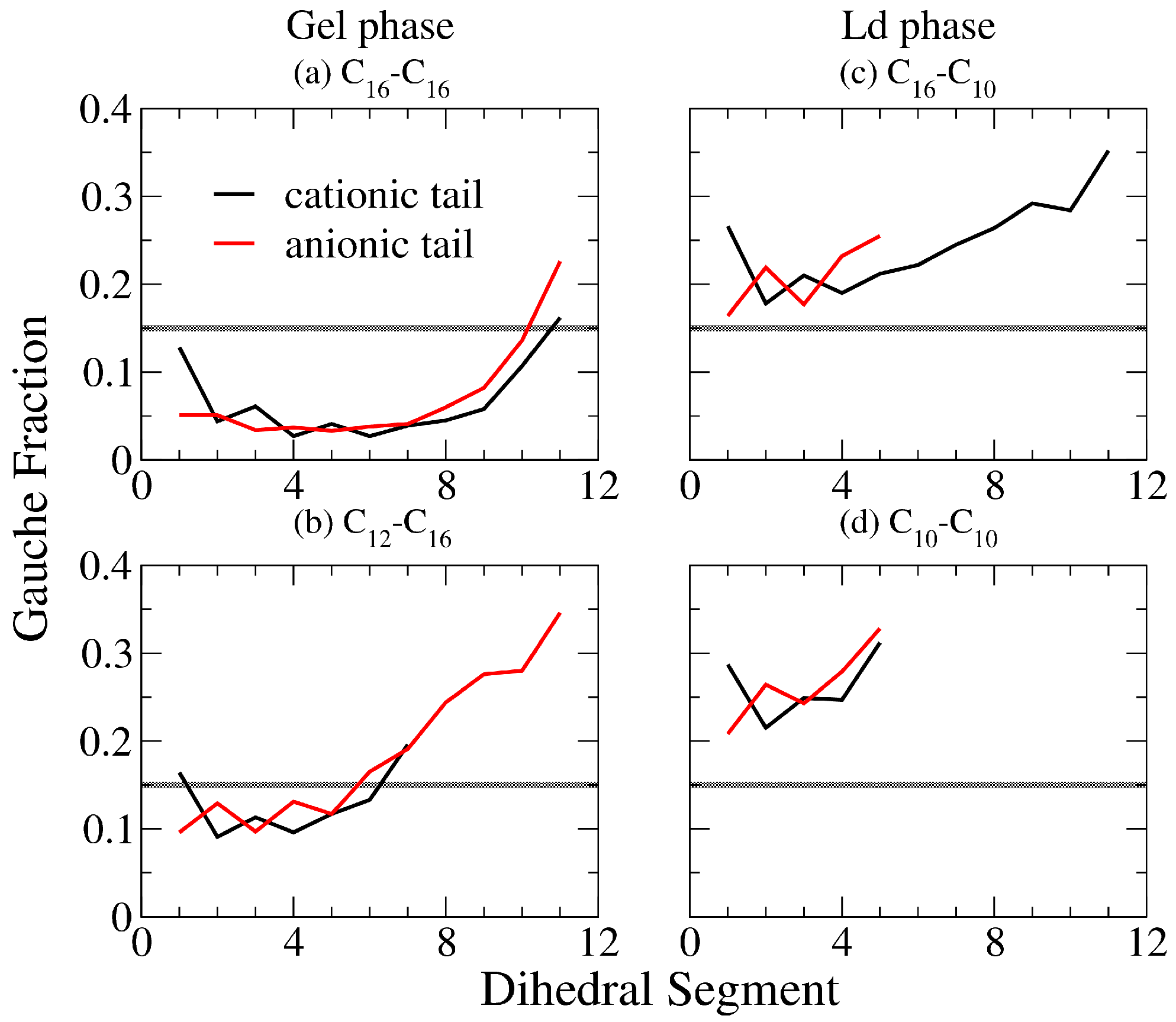
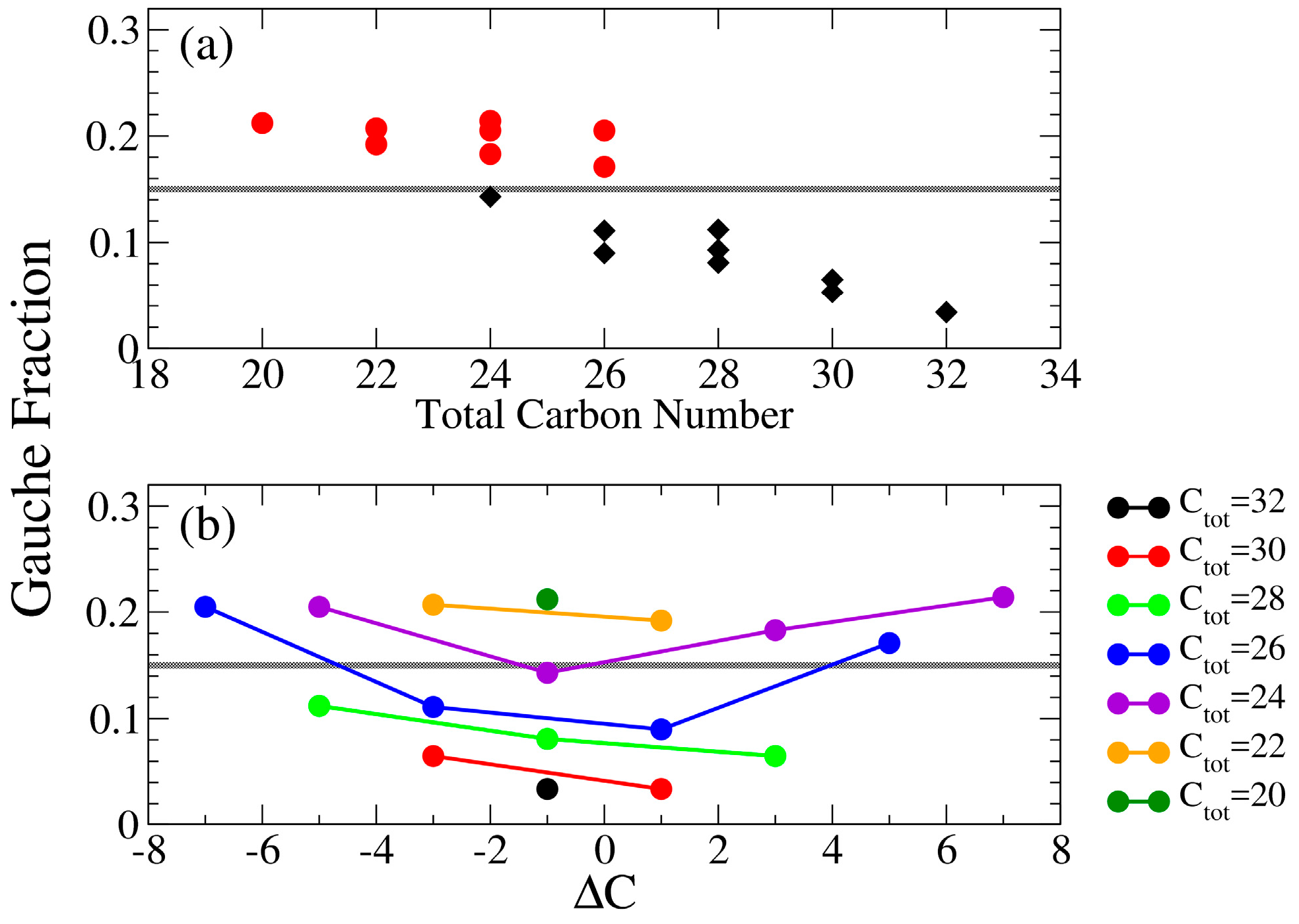
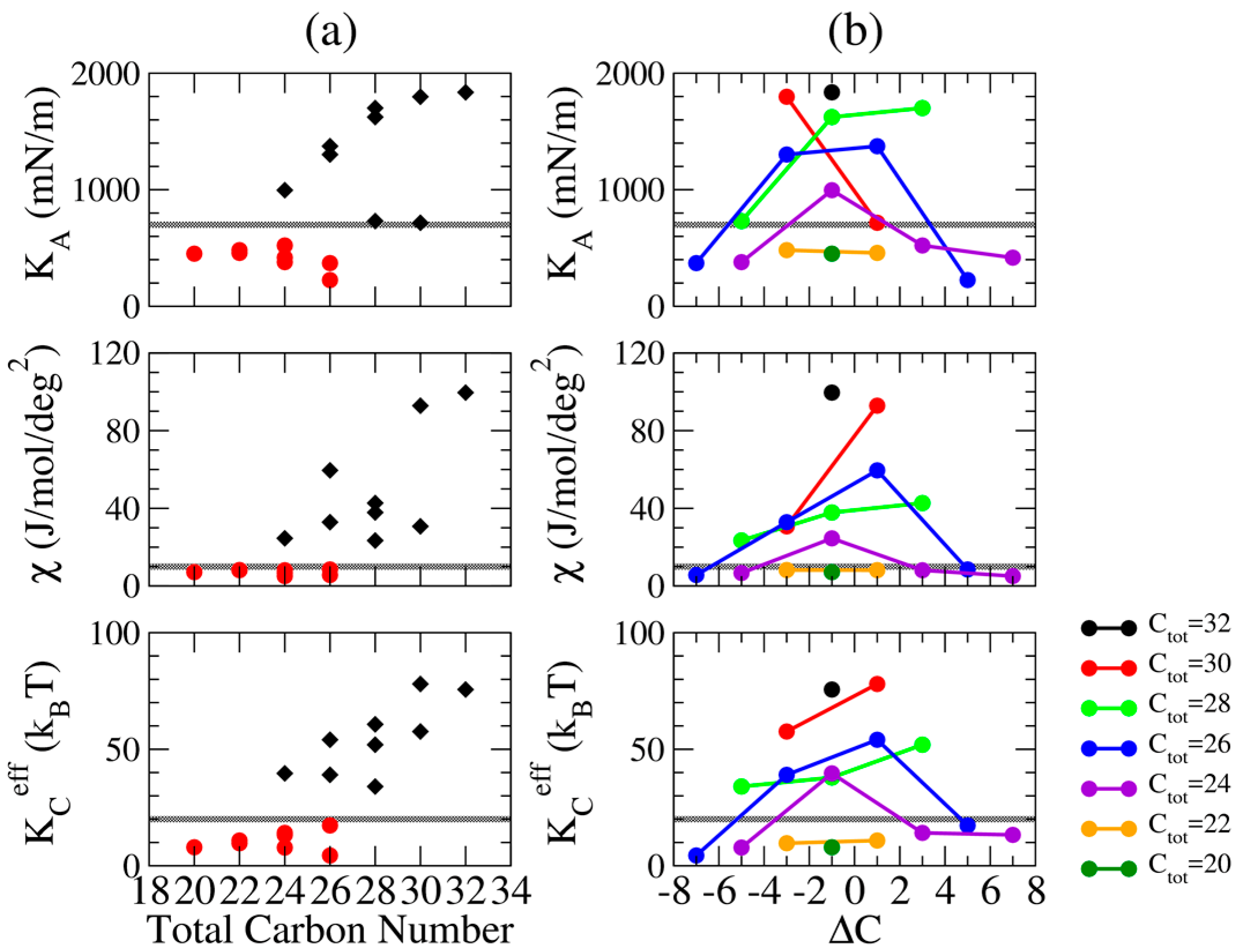
| m-n | 16 | 14 | 12 | 10 | |
|---|---|---|---|---|---|
| 16 | 16-16 | 16-14 | 16-12 | 16-10 | m-n |
| HTMA-HS | HTMA-TS | HTMA-DS | HTMA-DeS | Abbreviation | |
| 32 | 30 | 28 | 26 | Total Carbon | |
| −1 | 1 | 3 | 5 | ΔC | |
| 14 | 14-16 | 14-14 | 14-12 | 14-10 | |
| TTMA-HS | TTMA-TS | TTMA-DS | TTMA-DeS | ||
| 30 | 28 | 26 | 24 | ||
| −3 | −1 | 1 | 3 | ||
| 12 | 12-16 | 12-14 | 12-12 | 12-10 | |
| DTMA-HS | DTMA-TS | DTMA-DS | DTMA-DeS | ||
| 28 | 26 | 24 | 22 | ||
| −5 | −3 | −1 | 1 | ||
| 10 | 10-16 | 10-14 | 10-12 | 10-10 | |
| DeTA-HS | DeTA-TS | DeTA-DS | DeTA-DeS | ||
| 26 | 24 | 22 | 20 | ||
| −7 | −5 | −3 | −1 |
| m-n | 16 | 14 | 12 | 10 | |
|---|---|---|---|---|---|
| 16 | 16-16 | 16-14 | 16-12 | 16-10 | m-n |
| 0.425 | 0.428 | 0.428 | 0.476 | AIPA (nm2) | |
| 1835.75 | 716.70 | 1701.20 | 225.76 | KA (mN/m) | |
| 99.56 | 92.85 | 42.72 | 8.55 | χ (J/mol/deg2) | |
| 75.62 | 78.00 | 51.93 | 17.29 | (kBT) | |
| 0.333 | 0.305 | 0.381 | 0.289 | |SCD| | |
| 0.034 | 0.053 | 0.093 | 0.171 | Gauche Fraction | |
| 338.28 | 339.83 | 327.09 | N/A | Tm | |
| 14 | 14-16 | 14-14 | 14-12 | 14-10 | |
| 0.420 | 0.427 | 0.420 | 0.486 | ||
| 1797.40 | 1623.82 | 1373.57 | 521.80 | ||
| 30.72 | 37.86 | 59.55 | 8.14 | ||
| 57.59 | 60.71 | 54.05 | 14.12 | ||
| 0.385 | 0.380 | 0.387 | 0.285 | ||
| 0.065 | 0.081 | 0.090 | 0.183 | ||
| N/A | 328.28 | 332.80 | N/A | ||
| 12 | 12-16 | 12-14 | 12-12 | 12-10 | Threshold Values: |
| 0.430 | 0.431 | 0.440 | 0.492 | AIPA = 0.45 nm2 | |
| 730.84 | 1301.73 | 995.82 | 457.74 | KA = 700 mN/m | |
| 23.45 | 32.85 | 24.53 | 8.18 | χ = 10 J/mol/deg2 | |
| 34.02 | 39.03 | 39.67 | 10.85 | = 20 kBT | |
| 0.375 | 0.372 | 0.371 | 0.281 | |SCD| = 0.31 | |
| 0.112 | 0.111 | 0.143 | 0.192 | XGauche = 0.15 | |
| N/A | 320.05 | 314.52 | N/A | ||
| 10 | 10-16 | 10-14 | 10-12 | 10-10 | |
| 0.495 | 0.499 | 0.499 | 0.500 | ||
| 370.90 | 379.41 | 481.92 | 451.00 | ||
| 5.68 | 6.71 | 8.24 | 7.14 | ||
| 4.40 | 7.83 | 9.67 | 7.94 | ||
| 0.270 | 0.271 | 0.270 | 0.267 | ||
| 0.205 | 0.205 | 0.207 | 0.212 | ||
| N/A | 303.71 | 304.06 | N/A |
© 2017 by the authors. Licensee MDPI, Basel, Switzerland. This article is an open access article distributed under the terms and conditions of the Creative Commons Attribution (CC BY) license (http://creativecommons.org/licenses/by/4.0/).
Share and Cite
Chen, C.-h.; Tian, C.-a.; Chiu, C.-c. The Effects of Alkyl Chain Combinations on the Structural and Mechanical Properties of Biomimetic Ion Pair Amphiphile Bilayers. Bioengineering 2017, 4, 84. https://doi.org/10.3390/bioengineering4040084
Chen C-h, Tian C-a, Chiu C-c. The Effects of Alkyl Chain Combinations on the Structural and Mechanical Properties of Biomimetic Ion Pair Amphiphile Bilayers. Bioengineering. 2017; 4(4):84. https://doi.org/10.3390/bioengineering4040084
Chicago/Turabian StyleChen, Cheng-hao, Ching-an Tian, and Chi-cheng Chiu. 2017. "The Effects of Alkyl Chain Combinations on the Structural and Mechanical Properties of Biomimetic Ion Pair Amphiphile Bilayers" Bioengineering 4, no. 4: 84. https://doi.org/10.3390/bioengineering4040084





